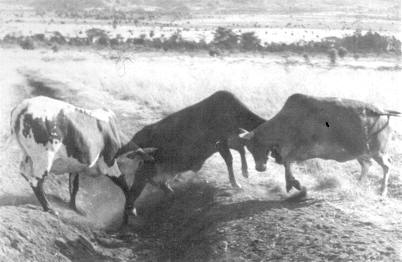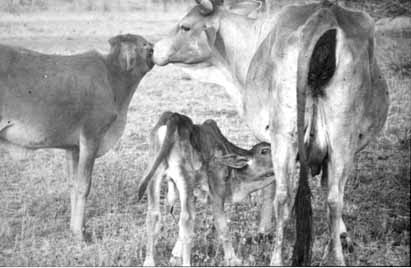Viktor Reinhardt
Animal Welfare Institute
Washington, DC
Evidence indicates that allowing beef calves to stay in the maternal herd beyond the age of natural weaning promotes animal welfare and may enhance the cows' natural reproductive potential.
Traditionally, calves of beef cattle are removed from their mothers well before the biologically predetermined age of weaning. Enforced mother-calf separation is stressful for the animals (Lefcourt & Elsasser, 1995) and often associated with coccidiosis, viral diarrhea, respiratory disease and death, constituting a significant economical loss. This common management practice is primarily based on the belief that allowing the cow to wean the calf herself would affect her reproductive performance, and hence the rancher's profit.
Cattle are managed to such an extent that the cows' biologically normal reproductive performance and the calves' biologically normal age of weaning and sexual behavior are largely unknown. Regardless of whether the young are forcibly weaned or left with their mothers, cows who have fertility problems are generally deemed uneconomical and, therefore, are culled, i.e., slaughtered. The removal of a herd's "substandard" cows automatically increases the average reproductive performance of the remaining "standard" cows, making it impossible to get a realistic picture of the natural reproductivity of beef cattle.
There is only one published report (Reinhardt, 1982) that assessed reproductive performance of cows who were not subjected to the usual culling system but had their calves either artificially or naturally weaned: Reproductive performance was determined in 96 "managed" and 18 "semi-wild" cows (Bos indicus) who lived on the same ranch (Kenplains Wildflife and Research Ranch, Kenya) in a semi-wild herd or in several managed herds of 40-60 animals each including one or two mature bulls.
- The calves of the managed herd were artificially weaned at the age of about 8 months. Being abruptly and permanently separated from each other was a traumatic experience, and the mother and her calf vocalized intensively and showed extreme restlessness for several days. After her calf had been taken away, the mother was also removed from the original herd and re-grouped with other dry cows and heifers. The establishment of hierarchical relationships with the members of the new group was always associated with overt aggressive interactions and high social tension (Figure 1). It took several days or even weeks until the animals calmed down and started to establish affiliative relationships with each other.
 |
|
Figure 1. Establishment of hierarchical relationships between "dry" cows after their calves had been taken away from them. |
- The calves of the semiwild herd were naturally weaned at the age of 7 to 14 months. The weaning process lasted up to 2 weeks. Female calves were prevented by their mothers from sucking any longer at an average age of 8.8 months, male calves significanly later at an average age of 11.3 months (Reinhardt & Reinhardt, 1981a). Weaning did not impair the affectionate bond between mother and calf (Figure 2). In fact, this bond was the foundation of the herd's cohesive social structure (Reinhardt & Reinhardt, 1981b). Weaned calves did not resume sucking when their mothers gave birth to the next offspring and lactated again. Male caves started copulating with oestrous cows upon reaching the age of about 16 months. They showed conspicuously little sexual interest in related females, and never copulated with their mothers (Reinhardt, 1983a). Female calves conceived at the average age of 25 months (Reinhardt & Reinhardt, 1981b).
 |
|
Figure 2. Weaning does not affect the bond between mother and calf. Here cow Aida of the semi-wild herd, nursing her newborn calf while affectionately grooming her 13-month old daughter whom she had weaned four months ago. Aida's mean calving interval was 338 days. She produced 9 calves - who were all alowed to stay with the maternal herd beyond the age of natural weaning - during a test period of 7.5 years (Reinhardt, 1983b). |
All 114 cows of this investigation calved in the course of second half of 1979. The time lapse to the next calving was calculated for each cow and taken as an index of her reproductive perfomance. This so-called "calving interval" averaged:
- 494±97 days in the 96 "managed" cows versus
- 388±73 days in the 18 "semi-wild" cows.
The difference of 106 days was statistically significant.
The data of the "semi-wild" African cows are comparable with those found in semi-wild European cows (Bos taurus): Average calving interval was 391 days in a study of a Scottish Highland cattle herd (Reinhardt et al., 1986), 380 days in another study of a German Fleckvieh cattle herd (Tost, 2000). Unfortunately, there are no comparative data of managed Bos taurus who were not subjected to the culling of "substandard" cows.
The better performance of the "semi-wild" cows cannot be attributed to different climatic or nutritional conditions. "Managed" cows, however, lived in a relatively unstable social environment. Not only were the affectionate ties with their still nursing calves permanently broken, but the social relationships with familiar herd members were artificially disrupted on a regular basis and the cows forced to establish new relationships with unfamiliar cattle. This high degree of social instability constituted a severe disturbance that possibly had a negative impact on the "managed" cows' reproductive system. Several reports have shown that the introduction of dairy cows to unfamiliar groups typically is accompanied by aggressive disputes, social stress and a reduction of productivity (Schein & Fohrman 1955; Porzig & Wenzel, 1969; Sambraus, 1971; Arave & Albright, 1976; Dobson et al., 2001). It is conceivable that the combined distress of losing the young, being removed from the familiar herd and being forced to integrate into an unfamiliar herd triggered many unnoticed abortions in the "managed" cows, leading to a prolongation of their calving intervals.
These findings suggest that the common practice of artificial weaning seriously impairs the welfare of the calf and of the mother, resulting in a depression of the cow's reproductivity. Recent studies (Price, Harris, Borgwardt, Sween, & Connor, 2002; Stookey, Schwartzkopf-Fenswein, Waltz & Watts, 1997) show that allowing the calves fenceline contact with their mothers for several days before being separated can attenuate behavioral distress responses It needs to be shown if these simple modification in the artificial weaning procedure buffers physiological stress responses in the cows so as to warrant unimpaired reproductivity.
References
Arave, C.W., & Albright, J.L. (1976). Social rank and physiological traits of dairy cows as influenced by changing group membership. Journal of Dairy Science, 59, 974-981.
Dobson, H., Tebble, J.E., Smith, R.F., & Ward, W.R. (2001). Is stress really all that important? Theriogenology, 55, 65-73.
Lefcourt, A. M., Elsasser, T. H. (1995). Adrenal responses of Angus x Hereford cattle to the stress of weaning. Journal of Animal Science, 73, 2669-2676.
Porzig, E., & Wenzel, G. (1969). Verhalten der Milchkühe nach der Umstellung aus dem Abkalbestall in den Boxenlaufstall. Tierezucht, 23, 535-537.
Price, E. O., Harris, J. E., Borgwardt, R. E., Sween, M. L., & Connor, J. M. (2002). Fenceline contact of beef calves with their dams at weaning reduces the negative effects of separation on behavior and growth rate. Manuscript submitted for publication.
Reinhardt, C., Reinhardt, A., & Reinhardt, V. (1986). Social behaviour and reproductive performance in semi-wild Scottish Highland cattle. Applied Animal Behaviour Science, 15, 125-136.
Reinhardt, V. (1982). Reproductive performance in a semi-wild cattle herd (Bos indicus). Journal of Agricultural Science, 98, 567-569.
Reinhardt, V. (1983a). Flehmen, mounting and copulation among members of a semi-wild cattle herd. Animal Behaviour, 31, 641-650.
Reinhardt, V. (1983b). Reproduktionsdaten einer halb-wilden Rinderherde. Verhandlungsbericht der 7. Veterinärmedizinischen Gemeinschaftstagung, 124-126.
Reinhardt, V., & Reinhardt, A. (1981a). Natural sucking performance and age of weaning in zebu cattle (Bos indicus). Journal of Agricultural Science, 96, 309-312.
Reinhardt, V., & Reinhardt, A. (1981b). Cohesive relationships in a cattle herd (Bos indicus). Behaviour, 77, 121-151.
Sambraus, H.H. (1971). Die soziale Rangordnung von Rindern und ihre Folgen. Der Tierzüchter, 9, 249-251.
Schein, M.W., & Fohrman, M.H. (1955). Social dominance relationships in a herd of dairy cattle. Animal Behaviour, 3, 45-55.
Stookey, J. M., Schwartzkopf-Fenswein, K. S., Waltz, C. S., & Watts, J. M. (1997). Effects of remote and contact weaning on behavior and weight gain of beef calves. Journal of Animal Science, 75(Supplement 1), 157.
Tost, J. (2000). Das Verhalten erwachsener Bullen in einer semi-natürlichen Rinderherde mit annähernd natürlicher Alters- und Geschlechtsstruktur (Doctoral Disseration).Kassel, Germany: Universität Gesamthochschule Kassel.
Reproduced with permission of Lawrence Erlbaum Associates
from Journal of Applied Animal Welfare Science 5(3), 247-251, 2002